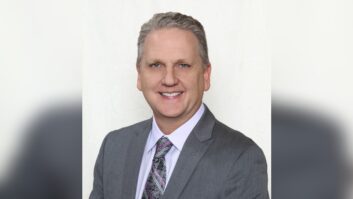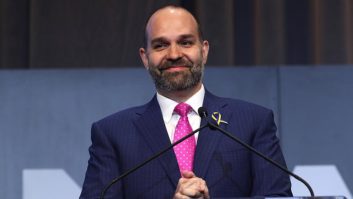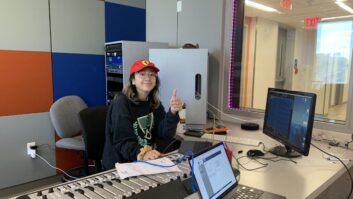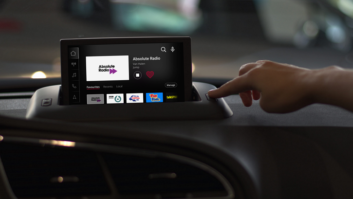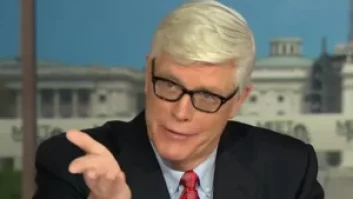WASHINGTON — When the National Association of Broadcasters brought Kevin Gage aboard in the spring of 2011, it placed him in a high-profile position, a new one at NAB that has direct responsibility to President/CEO Gordon Smith. Gage’s selection and the nature of the announcement seemed to send a message that NAB wants new technology to play a key role in how broadcasters reinvent their business models.

NAB brought in Kevin Gage, left, in the newly created position of executive vice president and chief technology officer. He is shown with Senior Vice President of Technology Victor Tawil and Senior Director of Advanced Engineering David Layer. Courtesy NAB
Gage has been spending much of his time on television spectrum issues in his first eight months as the executive vice president and chief technology officer, but he’s managed to get radio projects rolling as well.
An AM engineering study is underway. NAB has created a radio technology committee and is developing the “NAB Lab,” which will include radio as well as television work.
In a broad sense, he says, his job is to figure out where broadcasting will be technology-wise in the next few years and find ways radio and television stations can use technology advances to bring in new revenue streams.
Last fall, NAB quietly renamed its engineering division from NAB Science and Technology to simply “NAB Technology,” reflecting a broadening focus under Gage.
His background is in television and music digital platforms. He helped develop the DVD specification and production facilities at Warner Bros. Studios and helped launch the WB Network. He was head technologist at Warner Music Group, where he oversaw creation of new digital platforms and standards for products that included iTunes.
His résumé also includes a stint as an RIAA board member. He’s a Penn State University graduate who has a B.S. in science.
Radio World News Editor/Washington Bureau Chief Leslie Stimson spoke with Gage about the new NAB Lab and other technology matters including the creation of the radio engineering committee, in which several prominent industry engineers are participating.
RW: Why did NAB create your position?
Gage: Beyond the advocacy that NAB does, there’s a leadership role in the technology space that NAB can provide for the whole broadcasting marketplace. To do that, they felt they needed someone from the outside who had real-world digital technology and product development experience.
When they contacted me, they looked at my background and said, “Okay, you’ve done digital technology infrastructure, you’ve done business development, product development, strategic development as well as being a CTO.”
RW: Have you run into any surprises?
Gage: It wasn’t really an overall new experience because I’d been in the industry before, from the Time-Warner days. It’s just really re-discovering what the landscape is [now], and what are the drivers of where we need to go in the next five years.
RW: How is NAB’s technology department structured? The new name seems more broad.
Gage: It’s a little more broad. If you look at the mandate, it’s not just broadcasting, it’s broadcasting and all that’s collateral to broadcasting. As broadcasters, that’s where we are today.
It’s structured in four units: Victor Tawil from MSTV has a group that reports to him, and he reports to me. [The Association of Maximum Service Television was merged into NAB last June. It had worked with NAB to help shepherd the digital television transition.] Janet Elliott is head of my technology operations, she manages all the non-tech initiatives and events and organization, including our educational outreach that we’re going to try to build on.
With that in mind, John Marino is in charge of our technology education; that’s the show, the other seminars, taking on the Futures Summit, as well as building new curriculum that we will be announcing shortly for the NAB Show. Finally we have Lynn Claudy, who works really on the standards side, from his background working with the Advanced Television Systems Committee, and he has a couple [of people] under him as well.
RW: What can you say about these new initiatives?Are any radio-oriented?
Gage: Two of them are radio-oriented that we’re going to be doing at the show. It’s really creating curriculum for managers — not necessarily technologists, but managers — and try to make the language of technology … what is capable and what are the opportunities out there … to put it into language for managers: “If I want to go do X in a digital media space, here’s what I can do. Here are the success models and this is what I need to do as a station manager or a GM, and say, ‘This is what I need to do to enable my station or stations to do this.’”
We’re going to do the same type of curriculum on HD Radio. One of the initiatives that came out of our funding efforts here at NAB was a project that we’re working on with Emmis, iBiquity Digital and Intel to create HD Radio-enabled mobile phones. We’ve partnered with those core companies to basically do a straw-man proposal. Right now we’re using a dongle on a phone. Intel is working on getting their chip in a phone.
With that project, we’ve shown, with Emmis’ infrastructure … how to monetize that platform through advertising, and create a channel where you are not only broadcasting an HD Radio signal but you’re using the backchannel to create an even more immersive experience. With that presentation going around, that’s a great sign of innovation within the industry.
We want to say that if you are interested in this type of innovation, here is how you as an individual small-, medium-, large-market station owner can go out and implement this type of product into the marketplace. It’s really to give them, soup to nuts, if you want to implement this, instead of going out and trying to find that information, we’re going to put a curriculum together for you. This is how you would do it.
RW: This dovetails with what to do with Artist Experience?
Gage: That’s part of it. It’s Artist Experience, it’s an overall social experience as well as bringing contextual advertising into that type of personalized environment so that it all works together seamlessly without disrupting the consumer experience. But it allows a radio broadcaster to be more like what you would have as an online broadcaster or online streamer.
RW: The HD Alliance is conducting a survey among members to see where stations are with Artist Experience and what kind of assistance they would need to do it. Is NAB helping?
Gage: This is part of that. When we put out this curriculum, we’re actually working with operators. Something that’s key for me is I want to be able to really get the input of folks who’ve rolled up their sleeves, bruised a knuckle, bled a little bit and actually tried to implement something and seen the successes and failures … and get them to be part of this curriculum, vs. just creating something that wouldn’t necessarily have those real-world experiences attached to it.
RW: So one curriculum is on HD Radio. What’s the other radio curriculum?
Gage: It’s general digital. Neither of them has been announced so I don’t want to steal the convention’s thunder.
RW: What’s the concept behind the new NAB Lab?
Gage: The concept is to really give us an entity that is solely focused on driving the innovation that the [NAB] board was looking for.
In this case it’s going to be a support function, but it’s going to have a number of different functional units. Part of those functional units will be a showcase; we don’t showcase broadcast technology. In my brief time here, on the Hill, it still surprises people that there is innovation going on in the broadcast world. Because unless it’s touchy-feely and you have that visceral experience with it, [lawmakers] don’t believe it’s real.
So the easiest thing to do is to create a showcase that people can come in and see, have events and see what’s happening … because there’s nothing like that here in the beltway.
The incubator function is still going to be there. You’re right to say the FASTROAD program will be included. … We will help foster [some] projects but not necessarily work directly with them.

Kevin Gage
And then there will be a function in which we work directly with projects and partner with other companies and labs across the world on developing new innovation within the broadcasting and the collaterals of broadcasting. Which means there will also be a much more focused outreach on partnering with other companies — associations, companies and foreign organizations — to foster broadcasting of the future.
RW: Where will the lab be?
Gage: In the NAB building.
I’m trying to bring my start-up experience with me and saying, “Listen, we’ve just been given some seed funding.” That’s the way I want to approach it, though I know it’s a little different than that.
We have this seed funding; and now how can we be efficient and effective but also very dynamic in being able to create and produce and test different things in the marketplace? To be able to do that, I’m trying to create a little more of a virtual organization, and bringing in folks that we need as we need them. If we need to staff up over time, we will staff up over time in the areas that we’ve defined that we need to … but really take it more from a start-up standpoint: “Here’s a lab.”
If we need to work with folks who work remotely, they work remotely. They’ll have space internally to work on that. We’ll have the showcase internally. We’ll have a lot of our testing and other types of capabilities will still be in-house. But in this day and age, to get a brick-and-mortar lab is not really the most effective way of driving innovation. It saddles that entity with too many constrictions, as far as I’m concerned.
RW: NAB has testing equipment already?
Gage: We’ve got plenty of that and we can get more. Remember also we merged with MSTV, and with MSTV we got two excellent engineers [Victor Tawil and Bruce Franca] who’ve done a ton of testing in the RF space. They’re both considered experts and they both came out of the FCC [prior to MSTV].
RW: I’m curious how this effort will compare to NPR Labs.
Gage: We’ve had a little outreach to the NPR Labs. My understanding of NPR Labs is they’re a separate entity. We’re part of NAB. My understanding of NPR Labs is they do things internally; and they also do things for fee. That’s not our goal. Our goal here at NAB is to find ways to maximize or increase the overall broadcast market. We’re here about developing market vs. trying to develop individual products although that may come out of it. We’re here to tactically look in and say, “Okay, where are the areas that we can focus on innovation. How can we support our membership and the broadcasting community in general and then help expand in the development and innovation of the overall market?”
RW: Is your lab set up?
Gage: It’s being set up. We went through the initial approval of this in the October board meeting. It takes some time to go through the budgetary process and get us going.
RW: When will you be ready?
Gage: We’re already starting to spin up a little bit. One of your questions was about the AM engineering study. That’s one of the first things we’re taking on. … Instead of just going external to do that, we have internal people working on that as well, and setting up the AM engineering study. … It’s a mixture of us, external folks and of our radio broadcasting community coming in and working with us on that.
RW: What can you tell me about that study?
Gage: It’s too early to say much, other than I parse the problem as, “Where is radio five to 10 years from now; and what are the platforms that are potentially in place? What can we do with those platforms?”
When I say a platform, it can be cellular, mobile DTV, or TV Channels 5 and 6. There’s a number of different ways of looking at what the platform is. So it’s something that a business owner can say, “Okay, I want to be there, and that’s where my radio station will be broadcast to the world.”
The second part of that is what can be done with the AM band, because there are physics involved here with AM, on what can and cannot be done. As we know, the ambient noise that’s in the marketplace that affects the AM band is increasing and growing. So what can be done to help optimize what we can do with the AM band today?
Our goal is to lay out factually what we have discovered during this study to the board, and at that point in time, I think we will get the next steps of what we need to do.
RW: Are AM stations worried because they’re starting to see more portable devices that don’t have AM at all …
Gage: I don’t think it’s just one thing. I think the noise floor is one of the issues. Portability is another issue. The ability to deliver data is another ability.
There’s a number of different concerns to say, “How, on the AM band, can we compete with the other modes of distribution?” It’s not just one, it’s a multitude of those.
RW: Are you surveying your members …
Gage: Yes, another one of your questions is about the radio engineering committee. We have a TV engineering committee. They’re now called technology, not engineering committees — again, to have a larger mandate vs. just the engineering of radio but with the overall technology that goes behind it.
With the MSTV merger, we brought in a robust and dynamic group of guys that were managing the TV side, but what we didn’t have was [the] radio side. I started polling the industry at the board level, and had David Layer [senior director, advanced engineering for NAB] reach out at the engineering level; and we found there was, indeed, a strong interest in creating a technology group around radio. We formed that group.
RW: When was it created?
Gage: This committee was created in November. David Layer manages it. We just announced it internally to our membership. Barry Thomas of Lincoln Financial is going to be the chair and Jeff Littlejohn of Clear Channel Radio is going to be the vice-chair.
RW: Did this replace another committee or is it totally new?
Gage: It’s new. Within the technology side we inherited the TV group, we’ve expanded its charter and we formed the radio counterpart, which is the radio technology group. … When we formed this group and we reached out to the membership … some small but [also] a lot of medium markets showed an intense interest in being able to participate with it.
RW: You seem to be trying to broaden the broadcasters’ focus, technology-wise.
Gage: I think it’s really ramping it up and it’s reflective of where the market’s going. What is broadcasting today and where is it going in the future? And where are the technologies that surround broadcasting …which is anywhere from what you’re doing — actually broadcasting — to all your ancillary products that are dealing with broadcasting and tying it all together?
I would say yes, it is a broadening of the technology mandate within the NAB membership.
RW: How does HD Radio fit in with what NAB’s doing?
Gage: The key for our broadcasters is the ability to innovate; so we’re trying to support innovation across the board. With innovation, some will succeed, some will fail; but at the end of the day we’re supporting all these types of innovations, and HD Radio is one of those we support because we have broadcasters that support it. We think it’s actually an interesting product, but at the end of the day we’re all learning daily what it takes to put out that type of a product.
RW: It seems your job is to look ahead, to see how radio can be distributed on more platforms and to think more broadly. Is this what organizations need to be doing to think more broadly about to distribute their product?
Gage: I think that’s already happening. You’re looking at the innovation that’s happening in the marketplace today. It doesn’t always get the press necessarily that it should, at least what I see within the beltway. But there’s a lot of innovation going on. Our role is to help foster that innovation and potentially find new areas of where innovation can happen and be there at those early stages with both informational and technical support.
RW: It sounds like you’re going to make some changes to the Broadcast Engineering Conference at the spring convention.
Gage: We’ll make changes in the show. Whether it’s in the engineering conference or in the management conference or separate sessions altogether, there will be changes.






